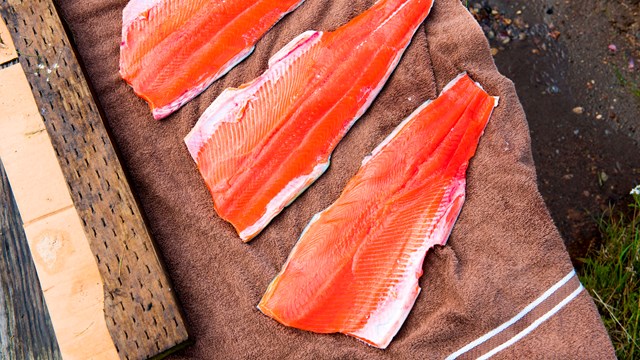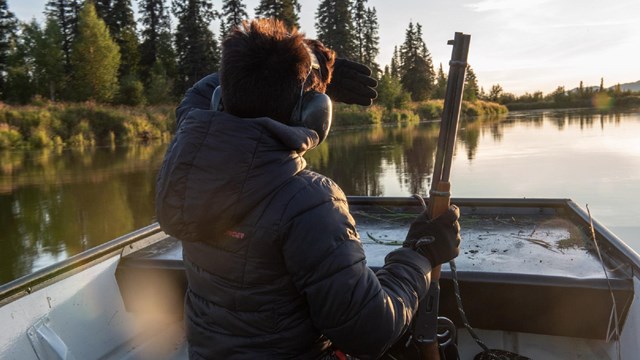Last updated: February 28, 2020
Article
Subsistence: Plant Harvesting

NPS/ D. Khalsa
Berries and other plants
For inland Dena’ina families, plants have always been a source of essential foods and medicines, as well as materials used for ceremony, decoration, tools, shelter, fuel, and many other purposes. Plant use is woven through most other aspects of traditional Dena’ina cultural practice. Though plant foods are not harvested in quantities comparable to the harvest of big game animals or fish, the harvest and processing of animal foods traditionally required a diverse range of plant materials. Required were not only woods used to produce traditional hunting and fishing gear as well as the sleds and boats used to access hunting and fishing sites. Wood was required for firewood to both cook and smoke animal foods. Significantly, plants were also used as ritual offerings, as seasonings, and in many other aspects of animal food procurement and processing. Technological advancements have eclipsed these practices today, yet some endure. Plant medicines, used externally or taken internally, continue to play an important role in the inland Dena’ina pharmacopeia. Moreover, traditional plant foods continue to be eaten widely in a community where access to outside produce remains expensive and unpredictable. Plants augment a diet still rich in animal foods. Finally, in addition to their nutritional and medicinal value, plants are a source of raw material utilized by inland Dena’ina craftspeople in the construction of shelter, tools, and transportation, thus “transforming the very forest around them into cultural objects
Reflecting the deep and enduring connection between people and plants, inland Dena’ina families possess extensive knowledge of plant habitats, and the seasonal availability, location, and harvest methods related to different plants. Many researchers have suggested that this is true of the historical Dena’ina: “Plant foods, hdenlyahi, ‘that which grows,’ were of great importance during the spring and summer growing season, but were collected year-round. … Like all hunter-gatherers, the Dena’ina had an intimate knowledge of their environment and of the edible and medicinal plants available at different times of the year." (Brian Fagan)
"In the old days you didn’t [kill for no good reason]. You only killed what you needed. You’d take some, but you’d leave some for next year. It’s that way with the plants – you only pick a little and leave behind some—berries and things like that—so more will come back in the next year. You were taking care of it. Respect! The land is our life." –Gladys Evanoff

NPS/ D. Khalsa
Dena’ina families traditionally eat berries both fresh and preserved. Large quantities of berries were formerly preserved in oil, though this practice has become less common with the availability of refrigerators, freezers, and canning technologies. Many elders have described the former practice. Albert Wassallie, for example, remembered his mother harvesting many pounds of cranberries and blackberries, and preserving them in oil, saying, “My, my mother used to pick enough berries, you know—a box full of cranberries and 50 pounds of blackberries, and…she put oil in there to preserve it—it keeps."
Significantly, medicinal harvests of berry plant products take place concurrent with modern berry harvests. Highbush cranberry tea is sometimes used to treat cold symptoms, and crushed cranberries are sometimes applied to sore throats. Inland Dena’ina families have used northern red currant (Ribes triste) nunask’et’i (‘that which hangs down’) or jeghdenghult’ila (‘ear it’s tied onto’) to make a tea to wash sore eyes. Inland Dena’ina families also use other parts of berry bushes beyond the fruit, such as leaves and stems. The stems and leaves of crowberries, for example, are a common cure for diarrhea and stomach problems, and are used to treat kidney ailments and eye infection: “they have wild tea…like blackberry leaves for diarrhea” (Nancy Delkettie). One Nondalton resident recalls that “[a] lot of different plants are important for being sick too, that blackberry leaves; they use that for stomachache, diarrhea, cramps in your stomach.”
Elders attest that the harvest and effective use of medicinal plants requires a detailed knowledge of the landscape (where to harvest), the flora (what plant to harvest and what time of year), and proper harvest methods (the desired part of the plant: leaves, root, flower, and the like). As is true in many places throughout Native North America, plants gathered from high elevations, such as on mountains, are said to be more potent than their lowland equivalents, even (perhaps especially) when the lowland plants are abundant. Enveloped in this understanding is a familiarity with the seasonal variations in plant products and reproductive cycles that dictate the availability and potency of certain plant components such as leaves, flowers, and roots. There appear to be both biochemical and cosmological bases for this view. When asked where the most important areas for plant harvests are located, elders such as Olga Balluta respond: “Up. Mostly upside the mountain, on top of the mountain, even right around here you could pick some up, just anywhere up on the hill. There’s a lot of plants that we could use” (Olga Balluta). Thus, while much medicinal plant gathering occurs along shorelines and trails in the lowlands, there is clearly a specialized pattern of upland plant harvesting of species such as Devil’s club, hellebore, and other species that brings people to higher elevations within the study area, even considerable distances
from villages.
“Plants are very important. There [are] plants right here all along the shore that they call it stlishlova—it’s like fireweed. They used to pick those and boil it with sugar and then make it thick with flour and make it look like pudding. …I mean, that was our pudding!" –Olga Balluta
PDF, 124 pages (14.6 MB)
Read the Traditional Use Study
Discover how inland Dena'ina people sustainably live from the land.

Explore the cultural tradition of fishing for salmon at fish camps.

Scope out more on the traditional hunting and trapping methods of inland Dena'ina people.
